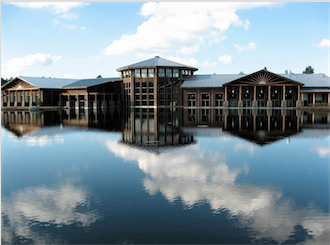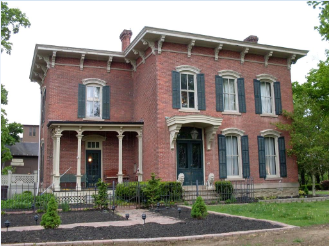Origins and Characteristics
Andrew Downing wrote two books about designing country houses in 1842 and 1850 that, with some help, launched the Italianate craze in the United States and the Adirondacks (Historical Styles). Italianate style buildings made a lot of sense for Americans, especially large families. Greek revival architecture, while imposing and impressive looking, lacked flexibility due to its emphasis on symmetry. Gothic architecture was another good option, but sometimes looked too “churchy” for a regular house. Many families chose Italianate architecture because it succeeded where the other styles did not. It was both flexible and inviting, the perfect style for the exploding population of America (Historical Styles).
_______________________________________________________________________________________________________

Towers
The Italianate style should not be confused with the Romanesque style. Italianate buildings attempted to replicate the beautiful villas of northern Italy and Tuscany, whereas Romanesque buildings copied elements of heavier, older structures like the Colosseum (McGowan, 39). The Italianate style was more often used in smaller residences in the country, whereas Romanesque style was used on Main Street, in an attempt to be imposing like Greek revival architecture.
Italianate houses are very pleasing to the eye. They almost always have a tower in the front, which can hexagonal or even octagonal, but is usually square (Historical Styles). Sometimes this tower is a
 room, but often it is simply decorative. Cupolas, like those on New England farm houses, are in fact diminished relics of the Italianate towers (McGowan 85). In less expensive Italianate houses, the tower is often replaced by an exaggerated oriel window, which is really just a half-tower built into the side of the house (Architectural Field Guide). The photo to the right depicts a historic Italianate house in Plattsburgh New York just slightly North of the Adirondacks. The tower is very visible, quite imposing from the road.
room, but often it is simply decorative. Cupolas, like those on New England farm houses, are in fact diminished relics of the Italianate towers (McGowan 85). In less expensive Italianate houses, the tower is often replaced by an exaggerated oriel window, which is really just a half-tower built into the side of the house (Architectural Field Guide). The photo to the right depicts a historic Italianate house in Plattsburgh New York just slightly North of the Adirondacks. The tower is very visible, quite imposing from the road.
The Adirondack's very own Wild Center, a fantastic museum for educating people about the ecosystems of the park, is built in the Italianate style. In the photo to the right, notice the large, central, imposing tower.
_______________________________________________________________________________________________________
Eaves and Decoration
An Italianate house is recognizable first by its tower, and the second by it’s deep, often very decorated eaves (Historical Styles).The photo of the red brick house to the right is a classic example of the Italianate eaves; they are deep, square, and ornamented. Although true Italianate houses are very decorated everywhere, the eaves are especially decorated with blocky and uniform wood carvings. Sometimes the cornice, (where the two roofs come together at the top) is filled with an intricate bracket (McGowan 80). The doors are of course also very decorated. They mirror the deep eaves with large hoods, decorated in the same style as the eaves, sometimes with glass paneling on the sides. Arched windows and doors were not as popular as the flat topped and decorated hoods,

Italianate houses epitomized the country life of the growing middle class. They were decorated, but plainer than Gothic revival structures, and much more practical and sensible than Greek revival structures. Romanesque architecture on the other hand, was seldom used by the middle class. Instead, the architects used Romanesque elements in grander, less habitable structures like churches (Architectural Styles). These churches and municipal structures were almost exclusively built with brick or stone, featuring arched windows, doors, and at least one circular window centered on the facade (McGowan 87). Blind arcades, arches with no door or window behind them, were used heavily for decoration along the roof line.
_______________________________________________________________________________________________________
Sources:
"Architectural Field Guide." Architectural Field Guide. Pennsylvania Historical and Museum Commission, n.d. Web. 05 Apr. 2015.
"Historic Styles / Italianate 1840-1885." Wentworth Studios. N.p., 16 Oct. 2014. Web. 05 Apr. 2015.
McGowan, Robert H. Architecture From The Adirondack Foothills. New York: Publishing Center for Cultural Resources, 1977. Print.
"Romanesque Revival." Architecture Landscape and Urban Design. N.p., 17 Oct. 2011. Web. 05 Apr. 2015.
Image Sources:
Court Street house: Photo uploaded by Mwanner, http://en.wikipedia.org/wiki/Court_Street_Historic_District_(Plattsburgh,_New_York)#/media/File:125_Court_Street,_Plattsburgh,_New_York.JPG
Wild Center: Photo uploaded by 888fortune~commonswiki,
http://commons.wikimedia.org/wiki/File:Wild_center_main_building.jpg
The Estate on Coffee Creek: Photo uploaded by Universal Pops, https://www.flickr.com/photos/universalpops/4635574036/
_______________________________________________________________________________________________________

